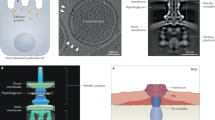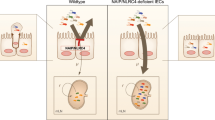Abstract
Specialized epithelia known as M cells overlying the lymphoid follicles of Peyer's patches are important in the mucosal immune system, but also provide a portal of entry for pathogens such as Salmonella typhimurium, Mycobacterium bovis, Shigella flexneri, Yersinia enterocolitica and reoviruses1,2,3,4. Penetration of intestinal M cells and epithelial cells by Salmonella typhimurium requires the invasion genes of Salmonella Pathogenicity Island 1 (SPI1)3,5,6,7,8,9. SPI1-deficient S. typhimurium strains gain access to the spleen following oral administration and cause lethal infection in mice5 without invading M cells3,9 or localizing in Peyer's patches10, which indicates that Salmonella uses an alternative strategy to disseminate from the gastrointestinal tract. Here we report that Salmonella is transported from the gastrointestinal tract to the bloodstream by CD18-expressing phagocytes, and that CD18-deficient mice are resistant to dissemination of Salmonella to the liver and spleen after oral administration. This CD18-dependent pathway of extraintestinal dissemination may be important for the development of systemic immunity to gastrointestinal pathogens, because oral challenge with SPI1-deficient S. typhimurium elicits a specific systemic IgG humoral immune response, despite an inability to stimulate production of specific mucosal IgA.
This is a preview of subscription content, access via your institution
Access options
Subscribe to this journal
Receive 51 print issues and online access
$199.00 per year
only $3.90 per issue
Buy this article
- Purchase on Springer Link
- Instant access to full article PDF
Prices may be subject to local taxes which are calculated during checkout




Similar content being viewed by others
References
Wolf,J. L. et al. Intestinal M cells: a pathway for entry of reovirus into the host. Science 212, 471–472 (1981).
Wassef,J. S., Keren,D. F. & Mailloux,J. L. Role of M cells in initial antigen uptake and in ulcer formation in the rabbit intestinal loop model of shigellosis. Infect. Immun. 57, 858–863 (1989).
Jones,B. D., Ghori,N. & Falkow,S. Salmonella typhimurium initiates murine infection by penetrating and destroying the specialized epithelial M cells of the Peyer's patches. J. Exp. Med. 180, 15–23 (1994).
Neutra,M. R., Frey,A. & Kraehenguhl,J. P. Epithelial M cells: gateways for mucosal infection and immunization. Cell 86, 345–348 (1996).
Galan,J. E. & Curtiss,R. III . Cloning and molecular characterization of genes whose products allow Salmonella typhimurium to penetrate tissue culture cells. Proc. Natl Acad. Sci. USA 86, 6383–6387 (1989).
Lee,C. A., Jones,B. D. & Falkow,S. Identification of a Salmonella typhimurium invasion locus by selection for hyperinvasive mutants. Proc. Natl Acad. Sci. USA 89, 1847–1851 (1992).
Francis,C. L., Ryan,T. A., Jones,B. D., Smith,S. J. & Falkow,S. Ruffles induced by Salmonella and other stimuli direct macropinocytosis of bacteria. Nature 364, 639–642 (1993).
Collazo,C. M. & Galan,J. E. The invasion-associated type III protein secretion system in Salmonella—a review. Gene 192, 51–59 (1997).
Pehheiter,K. L., Mathur,N., Giles,D., Gahlen,T. & Jones,B. D. Non-invasive Salmonella typhimurium mutants are avirulent because of an inability to enter and destroy M cells of ileal Peyer's patches. Mol. Microbiol. 24, 697–709 (1997).
Baumler,A. J., Tsolis,R. M., Valentine,P. J., Ficht,T. A. & Heffron,F. Synergistic effect of mutations in invA and lpfC on the ability of Salmonella typhimurium to cause murine typhoid. Infect. Immun. 65, 2254–2259 (1997).
Shang,X. Z. & Issekutz,A. C. Contribution of CD11a/CD18, CD11b/CD18, ICAM-1 (CD54) and -2 (CD102) to human monocyte migration through endothelium and connective tissue fibroblast barriers. Eur. J. Immunol. 28, 1070–1979 (1998).
Fields,P. I., Swanson,R. V., Haidaris,T. G. & Heffron,F. Mutants of Salmonella typhimurium that cannot survive within the macrophage are avirulent. Proc. Natl Acad. Sci. USA 83, 5189–5193 (1986).
Wilson,R. W. et al. Gene targeting yields a CD18-mutant mouse for study of inflammation. J. Immunol. 151, 1571–1578 (1993).
Kishimoto,T. K. & Anderson,D. C. in Inflammation: Basic Principles and Clinical Correlates 2nd edn (eds Gallin, J. I., Goldstein, I. M. & Snyderman, R.) 353–406 (Raven, New York, 1992).
Conlan,J. W. & North,R. J. Listeria monocytogenes, but not Salmonella typhimurium, elicits a CD18-independent mechanism of neutrophil extravasation into the murine peritoneal cavity. Infect. Immun. 62, 2702–2706 (1994).
Baumler,A. J., Tsolis,R. M. & Heffron,F. The lpf fimbrial operon mediates adhesion to murine Peyer's patches. Proc. Natl Acad. Sci. USA 93, 279–283 (1996).
Gerichter,C. B. The dissemination of Salmonella typhi, S. paratyphi A and S. paratyphi B through the organs of the white mouse by oral infection. J. Hyg. 58, 307–319 (1960).
Bernstein,C. N., Sargent,M., Gallatin,W. M. & Wilkins,J. β2-integrin/intercellular adhesion molecule (ICAM) expression in the normal human intestine. Clin. Exp. Immunol. 106, 160–169 (1996).
Oskoui,R., Davis,W. & Gomes,M. N. Salmonella aortitis. A report of a successfully treated case with a comprehensive review of the literature. Arch. Int. Med. 153, 517–525 (1993).
Neutra,M. R. Current concepts in mucosal immunity. V. Role of M cells in transepithelial transport of antigens and pathogens to the mucosal immune system. Am. J. Physiol. 274, G785–791 (1998).
Autenrieth,I. B., Kempf,V., Sprinz,T., Preger,S. & Schnell,A. Defense mechanisms in Peyer's patches and mesenteric lymph nodes against Yersinia enterocolitica involve integrins and cytokines. Infect. Immun. 64, 1357–1368 (1996).
Tsolis,R. M., Bauler,A. J., Stojiljkovic,I. & Heffron,F. Fur regulon of Salmonella typhimurium: identification of new iron-regulated genes. J. Bacteriol. 177, 4628–4637 (1995).
Valdivia,R. H. & Falkow,S. Bacterial genetics by flow cytometry: rapid isolation of Salmonella typhimurium acid-inducible promoters by differential fluorescence induction. Mol. Microbiol. 22, 367–378 (1996).
Rahn,K. et al. Amplification of an invA gene sequence of Salmonella typhimurium by polymerase chain reaction as a specific method of detection of Salmonella. Mol. Cell. Probes 6, 271–279 (1992).
Kinder,S. A., Badger,J. L., Bryant,G. O., Pepe,J. C. & Miller,V. L. Cloning of the YenI restriction endonuclease and methyltransferase from Yersinia enterocolitica serotype O:8 and construction of a transformable R-M+ mutant. Gene 136, 271–275 (1993).
Miller,V. L. & Mekalanos,J. J. A novel suicide vector and its use in construction of insertion mutations; osmoregulation of outer membrane proteins and virulence determinants requires toxR. J. Bacteriol. 170, 2575–2583 (1988).
Stojiljkovic,I., Baumler,A. J. & Heffron,F. Ethanolamine utilization operon of Salmonella typhimurium: nucleotide sequence, protein expression and mutational analysis of the cchB eutE eutJ eutG eutH gene cluster. J. Bacteriol. 177, 1357–1366 (1995).
Valentine,P. J., Devore,B. P. & Heffron,F. Identification of three highly attenuated Salmonella typhimurium mutants that are more immunogenic and protective in mice than a prototypical aroA mutant. Infect. Immun. 66, 3378–3383 (1998).
Berggren,R. E. et al. HIV gp120-specific cell-mediated immune responses in mice after oral immunization with recombinant Salmonella. J. AIDS 10, 489–495 (1995).
Acknowledgements
This work was supported in part by grants from the NIH (A.V.T., J.J.C., A.B., R.B. and F.F.), the United States Department of Agriculture (A.B.), and the James Biundo Foundation (F.F.). The authors are grateful to E. Balish for constructive review of the manuscript and thank F. Heffron and S. Moller for the gifts of strains CL1509 and SM022, respectively.
Author information
Authors and Affiliations
Corresponding author
Rights and permissions
About this article
Cite this article
Vazquez-Torres, A., Jones-Carson, J., Bäumler, A. et al. Extraintestinal dissemination of Salmonella by CD18-expressing phagocytes. Nature 401, 804–808 (1999). https://doi.org/10.1038/44593
Received:
Accepted:
Issue Date:
DOI: https://doi.org/10.1038/44593
This article is cited by
-
The Prophylactic Protection of Salmonella Typhimurium Infection by Lentilactobacillus buchneri GX0328-6 in Mice
Probiotics and Antimicrobial Proteins (2023)
-
Investigation of the invasion mechanism mediated by the outer membrane protein PagN of Salmonella Typhimurium
BMC Microbiology (2021)
-
A detailed analysis of innate and adaptive immune responsiveness upon infection with Salmonella enterica serotype Enteritidis in young broiler chickens
Veterinary Research (2021)
-
Facile accelerated specific therapeutic (FAST) platform develops antisense therapies to counter multidrug-resistant bacteria
Communications Biology (2021)
-
Salmonella enterica serovar Typhimurium sseK3 induces apoptosis and enhances glycolysis in macrophages
BMC Microbiology (2020)
Comments
By submitting a comment you agree to abide by our Terms and Community Guidelines. If you find something abusive or that does not comply with our terms or guidelines please flag it as inappropriate.



